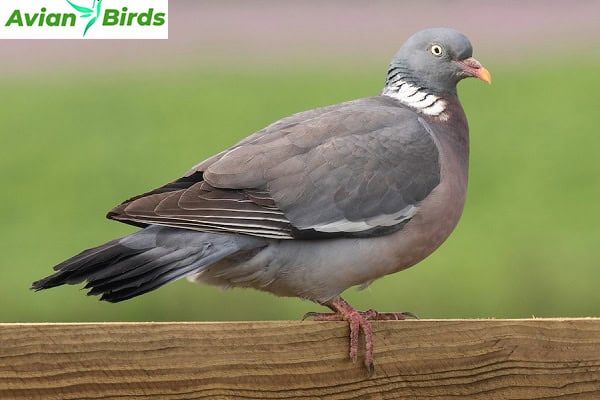Learn About Common Wood Pigeon – Facts, Diet, Habitat
Ever wondered why the Common Wood Pigeon visits our gardens and parks? This bird’s world is full of surprising facts that challenge what we thought we knew. We’ll explore the key aspects of the Common Wood Pigeon, like its diet, home, and unique traits. You’ll also find beautiful images to enjoy.
Join us on a fascinating birdwatching adventure. We’ll reveal the secrets of the Common Wood Pigeon (Columba palumbus) and its interesting life.
~Here we’ll discuss the Common Woodpigeon and its characteristics~
Fun Facts
- Lifespan – 3 to 6 years on average, but can live up to 17 years.
- Weight – 300-615 grams (10.6-21.7 oz).
- Length – 38-44 cm (15-17 inches).
- Wingspan – 68-80 cm (27-31.5 inches).
- Family – Columbidae (Pigeons and doves)
- Diet – Mainly seeds, grains, berries, and leaves, but also enjoy crops like peas and cabbages.
- Habitat – Found in woodlands, farmlands, gardens, and urban areas across Europe and western Asia.
- Breeding – They typically lay two white eggs per clutch and can have multiple broods per year.
- Nest – A flimsy platform made of twigs, usually built in trees, hedges, or on building ledges.
Introduction to the Common Woodpigeon
The Common Wood Pigeon is a bird species that captures our interest. It lives in many places, from woodlands to cities. This bird is adaptable and can be seen in various environments.
It’s known for its unique sounds. The Common Wood Pigeon makes a low, throaty cooing noise. This sound is well known to birdwatchers and nature lovers. As you learn more about these birds, you’ll see how they’ve adapted to different environments.
Learning about the Common Wood Pigeon means understanding its role in nature. It shows how these birds interact with their surroundings. This knowledge makes observing them in the wild more meaningful.
Identification and Physical Characteristics
Learning to spot Common Wood Pigeons can be fun for bird lovers. This section shares key traits that set them apart from other pigeons. Knowing their size and colors helps you recognize and enjoy these birds more.
Distinctive Features
The Common Wood Pigeon is easy to spot because of its big size and striking white wing band when it flies. It also has a white neck patch, but young ones might not have it in late summer and autumn. These features make them stand out among other birds.

Coloration and Size
Adult Wood Pigeons have beautiful shades of lilac and gray. Their neck patches change with their location, showing how they adapt to different places. They are usually 14 to 16 inches long and have wings up to 26 inches wide. These sizes and colors make them easy to identify, whether they’re flying or perched.
Common Woodpigeon Habitat
Learning about the Common Wood Pigeon’s home shows how well they adapt. They live in many places, both in nature and the city.
Natural Habitat Preferences
Wood pigeons love living near woods, parks, gardens, and farmlands. They used to hang out at the edges of pine-oak forests. But now, they’re also in the city, showing how flexible they are.
Urban Adaptations
Urban wood pigeons have made the city their home. They eat in parks and gardens, showing they can live in many places. Since the 1800s, they’ve moved into cities, proving they can find food and shelter anywhere.
Diet of the Common Woodpigeon
The wood pigeon eats mostly plants, showing its key role in nature. Knowing how they eat helps us see how they live in different places and affect farms.
Feeding Behavior
Common Wood Pigeons have unique ways of finding food. They search on the ground with their beaks. This helps them find different plants, showing their vital role in nature.
Their flexible eating habits help them survive in various places.
Types of Food Consumed
These birds eat a wide range of foods. Leaves, buds, seeds, and fruits are big parts of their diet. Sometimes, they even eat insects. They like over 100 types of crops, including wheat and corn, which affects local plants.
Impact on Agriculture
Wood pigeons can cause a lot of damage to crops. Large groups can harm farm produce. It’s important to understand their eating habits to manage their numbers, especially in farms where they can reduce crop yields.
Behavior and Nesting of the Common Woodpigeon
The Common Wood Pigeon shows interesting behaviors and unique nesting patterns. Their habits and social interactions are quite fascinating. Let’s explore their nesting habits, reproductive behavior, and special display flights that make their life vibrant.
Nesting Habits
Wood pigeons make simple stick nests that they often reuse and add to over the years. These nests are usually found in trees, about 7 feet off the ground. This spot keeps their young safe and protected.
Reproductive Behavior
Common Wood Pigeons have one to two broods a year. Both parents take turns incubating and feeding their chicks. This teamwork during the breeding phase shows a strong bond between them. It helps create a caring environment for their babies.

Display Flights
Wood pigeons also have amazing display flights. They start with a rhythmic flap-flap-flap climb, then glide back down gracefully. These flights help them find mates and mark their territory. They’re key to their success in finding a mate and raising their young.
Wrapping UP…
The Common Wood Pigeon is more than just a common bird. It plays a key role in keeping our ecosystems balanced. They live in many places and have interesting ways of eating and reproducing. This makes them a stable and loved part of the bird world.
Today, wood pigeons are classified as Least Concern for Conservation. This is because they have many birds and live in various places. Yet, it’s important to keep watching and learning about them. This helps make sure they stay important in our ecosystems.
Learning about the Common Wood Pigeon, from their flexible nature to their role in nature, makes our time in nature richer. Supporting conservation efforts helps ensure these birds will be around for future generations.







